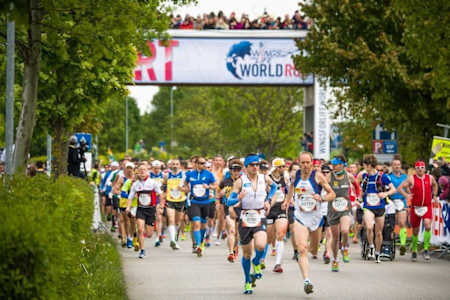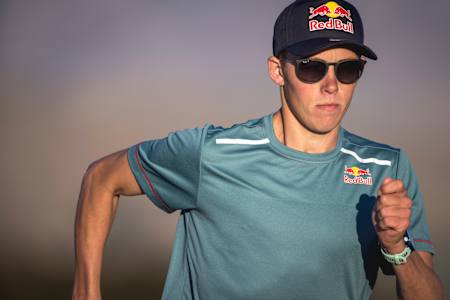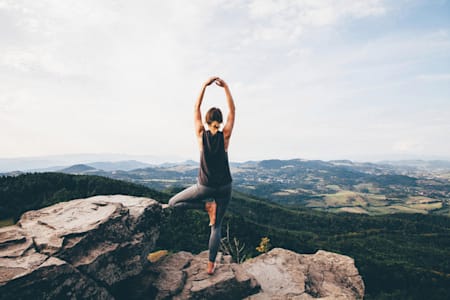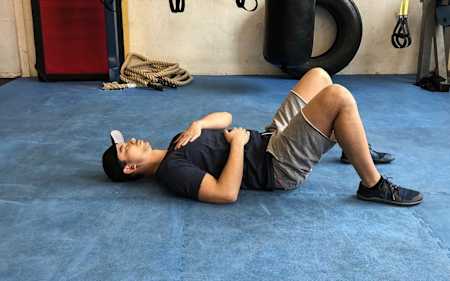Fitness
“We need to treat breathing exercises the same as physical exercises," says Galway-based breathing coach Patrick McKeown. "You need to dip your toe into the water and see how your body responds. You can always change the dose and duration of a breathing exercise to suit you.”
Regularly working with top athletes to monitor their airways and rapidly boost performance by natural means, McKeown is also the mind behind the Oxygen Advantage — not so much a brand but a whole movement encompassing a book, online support, and even an app helping users in rewiring and reframing their approach to taking a breath.
And if you were one of the hundreds of competitors to duck, weave and dodge their way around the countryside at one of the recent Red Bull Conquer the Castle events, or even at the Wings for Life World Run [pictured] you'll know first-hand just how hard it is to stay focused when getting a wheeze on.
And it turns out you're not alone. “Even the very best athletes have dysfunctional breathing," says McKeown, who will often employ diaphragmatic breathing techniques to really bring the stomach into play when we breathe.
However, before we delve into some of these game-changing breathing exercises, here our expert answers answers some of the most asked questions on the topic....
What is the optimum resting breathing rate?
"Most people will say between 12 and 16 breaths per minute. But there's a lot that needs to be taken into account. What about the volume of air that’s drawn into the lungs during each breath? Or the health of a person? Studies have shown that 50% of people with lower back pain having disordered breathing, while 75% of those affected by anxiety and panic disorder have dysfunctional breathing. Dysfunctional breathing and dysfunctional movement go together. Even if you think your breathing is fine, it may not be."
Employ a few breathing holds and your running will improve no end
© Ozer Ozsari/Red Bull Content Pool
What part of the brain controls breathing?
"Breathing is controlled in the brain stem, which is a stalk-like structure connecting the brain to the spinal cord. The primary drive to breathe is actually carbon dioxide, when a lot of people think it’s oxygen. This is important because if you have an individual who is overly sensitive to the accumulation of carbon dioxide, that person is going to be breathing faster and harder during sleep, rest and physical exercise."
Can I use breathing to destress during sport?
"Absolutely. A very simple tool to use if you’re feeling stressed and want your body to tell the brain that everything is ok, is to take a soft breath in through the nose and have a really slow gentle breath out according to how you feel, relative to how you normally breathe. Now your body is telling the brain that everything is good, and the brain is going to send signals of calm to the body as a result."
Is the famed '4-7-8 breathing' technique useful?
"Not necessarily. If you break down this method — inhalation for 4 seconds, holding for 7 seconds, breathing out for 8 seconds — not everybody’s able to do it. That’s slowing the respiratory rate to two or three breaths per minute, and it’s not taken into consideration whether it’s through the nose or the mouth, nor taking into consideration lung volume. You could have one individual breathing in very softly for 5 seconds, holding for 7 seconds, exhaling for 8 seconds. Or you could have someone taking in a full big breath. It's all subjective."
Now, for 4 breathing exercises which really will transform your health and athletic performance, read on...
01
Pre-sleep prep
Why: "50% of the adult population are mouth breathing during sleep, and they’ll wake up feeling groggy and irritable. When we talk about athletic performance, this starts the night before…"
When: Every night before you sleep.
How:
• Put one hand on your chest and one hand just above your naval, or have your hands on your lap.
• Now take a really soft breath through your nose, and a relaxed and slow gentle breath out.
• The whole purpose is to breathe less air. By breathing less air, carbon dioxide accumulates in the lungs and blood and this stimulates the vagus nerve and eventually you’ll start to feel sleepy.
• Do this 10 minutes before sleep and you'll be down-regulating. Before you know it this will help you go into a deep sleep.
• If you want to ensure the best results, you can buy a tape that surrounds the lips, bringing the lips together without forcefully closing them, called Myotape.
The benefits: "The benefits of breathing light during sleep is that it stimulates the vagus nerve to activate the body's rest and digest response. As you practice softening your breathing to create a tolerable air hunger, it will make you feel sleepy. This exercise will not only make you feel sharper ahead of any event the following day but can also improve sleep recovery after heavy physical exertion."
02
The jogging booster
Why: "Breathe in and out through your nose during a light run to improve oxygenation of working muscles. These easy breath holds will help warm up the body, while making you stronger mentally and physically."
When: A few minutes into a light jog.
How:
• Early into a jog, breathe in and out of the nose and pinch your nose, holding your breath for 10 or 15 paces.
• Let go and breathe normally for a minute and then do it again.
• When you feel up to it, increase your breath hold — take a normal breath in through your nose and out, pinch your nose and hold, and keep jogging.
• Do it right and you will feel involuntary contractions of the diaphragm. It’s a stresser, but keep relaxing into it, keep going, keep pushing, and when the air hunger is moderate to strong let go, breathe in through the nose, get your breathing under control and continue jogging.
Benefits: "By nose breathing like this you’re protecting your airways. You’re also conserving moisture – a runner with their mouth open is more likely to have dry mouth and also be dehydrated. This will also increase visual spatial awareness, which applies more to those in team sports, where you have to have your eye on a ball, and also triathletes, who always have to be scanning their environment.
"Nose breathing during physical exercise reduces breathing volume. The idea behind this is that it improves CO2 tolerance, which means you're not going to be breathing as hard or fast during physical exercise."
03
Box breathing
Why: "Box breathing is also known as tactical breathing. It is a popular exercise used by Navy Seals or Special Weapons and Tactics personnel (SWAT). Individuals going into stressful and difficult situations want to have balance in their autonomic nervous system."
When: Before a sporting event or even a stressful situation like a work or uni presentation.
How:
• Breathe in silently through your nose for 4 seconds. Hold for 4 seconds.
• Breathe out silently through your nose for 4 seconds. Hold for 4 seconds.
• Repeat these steps for two to four minutes.
Benefits: "Box breathing allows you to be both alert and relaxed at the same time while also helping to keep your nervous system under control and you to perform at your best."
04
Breathe light
Why: "Having breathing control in sport will result in reduced breathlessness during physical exercise."
When: Anytime you like.
How:
• Place your index finger under your nose. Use your finger as a barometer of the air flow coming from your nose.
• Take a soft gentle breath into your nose. Your breathing should be almost imperceptible. Breathe so softly that you feel hardly any air coming into your nose.
• As you gently exhale, breathe out so slowly that you feel hardly any air on your finger.
• The whole objective is to slow your breathing so less air enters your body.
Benefits: "What’s the problem with having dysfunctional breathing? You’re likely to have respiratory muscle fatigue, you’re likely to gas out too soon. You’re not likely to have the same endurance. You’re likely to have increased levels of breathlessness. You’re wasting energy unnecessarily. And this exercise will help you to control your breathing. It's big because it’s your everyday breathing is what's going to influence your degree of movement during physical activity."
Employ a few of those exercises and gradually you'll build a tolerance and feel the benefits for sport and even everyday life.
Just bear in mind that no one exercise is the same for everyone — a bit of resistance is fine but if you ever feel uncomfortable then simply stop the exercise. You can even reach out to a certified breathing coach if you want an individual regime tailored around you.
And for an insight into how McKeown has become one of the most outstanding breathing coaches in Europe, here he explains some of the work he's recently done with a "world class" boxer, including diaphragmatic breathing.
"The warmup we do is all about breathing in and out through the nose, I have the individual starting off with fairly light physical exercise [i.e. rope jumps] and intensifying the exercise while maintaining nose breathing.
"I’ll often want them to be breathing low, so often I’ll either get them to wear a weighted belt we use, or I’ll get the boxer to put their hands at either side of their lower ribs, because I want to engage the diaphragm, which provides stablisation for the spine. Their posture and movement is going to be influenced by the ability to tap into good recruitment of the diaphragm.
"Breathing light and breathing low is also helping to stimulate the vergas nerve, which will lower the heart rate. So, I use the warmup to downregulate in case their heart rate is too ramped up, I want to bring it down. Then I bring in breath holding, so he could be doing shadow boxing for example and I’ll have him exhale and hold his breath for about 15 paces, 15 steps, then breathe normally for about a minute and repeat it.
"After that I have them do five strong breath holds: I put the boxer into an oxygen debt, increasing the carbon dioxide and put him in an oxygen debt. This is a stresser, this is to get them out of their head, but also to stress the body as well, as it increases blood to the brain."
Naturally, this regime, designed for a professional at the top of their game, isn't for everyone, but it does offer a glimpse into the synchronicity of breathing and movement and how these can be manipulated at the highest level of sport. As for you, next year's Wings for Life World Run won't know what hit it.
For more tips and tools to make enhance your breathing for sport, download the Oxygen Advantage app or visit the website.







